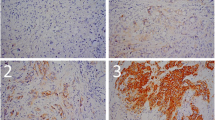Abstract
Insulin-like growth factor II receptor (IGF2R) degrades mitogen and hence is associated with tumor suppressor function. The aim of this study was to assess whether genetic variation in the mitogen-binding domain of IGF2R, Gly1619Arg, disrupts normal function of IGF2R and contributes to further progression and distant metastasis of localized oral squamous cell carcinoma (OSCC). Gly1619Arg polymorphism of IGF2R domain 11 (rs629849) was assessed in blood samples of 113 individuals with histology-confirmed OSCC, and IGF2R genotypes were correlated with the stage of tumor (localized; TMN stages I–II versus advanced; TMN stages III–IV). After controlling for demographic covariates and known risk factors for oral cancer, such as tobacco, alcohol, and areca nut use, threefold increased risk of advanced stage of OSCC was noted in those subjects who had one or two copies of the IGF2R-A-allele when compared with the GG genotype. In contrast, when compared with the carriers of the A-allele, the GG genotype demonstrated to be protective against advanced disease (adjusted odds ratios of 0.32). IGF2R genetic polymorphism may be associated with decreased function of IGF2 receptor there by contributing to the advancement and distant metastasis of localized oral cancer.
Similar content being viewed by others
References
Mao L, Hong WK, Papadimitrakopoulou VA. Focus on head and neck cancer. Cancer Cell. 2004;5:311–6.
Neville BW, Damm DD, Allen CM, Bouquot JE. Epithelial pathology. In: Schrefer J, Rudolph P, Alvis K, McKinley L, Forest E, Ramirez J editors. Oral and maxillofacial pathology, 3rd ed. Philadelphia, PA: Saunders; 2007. p 315–88.
Cardesa A, Gale N, Nadal A, Zidar N. Squamous cell carcinoma. In: Barnes L, Eveson JW, Reichar P, Sidransky D editors. World Health Organization Classification of tumors, pathology and genetics of head and neck tumors. Lyon, France: IARC Press; 2005. p 118–21.
Zavras AI, Pitiphat W, Wu T, Cartsos V, Lam A, Douglass CW, Diehl SR. Insulin-like growth factor II receptor gene-167 genotype increases the risk of oral squamous cell carcinoma in humans. Cancer Res. 2003;63:296–7.
Zavras AI, Douglass CW, Gorgoulis VG. The role of IGF2R in carcinogenesis. Nat Rev Cancer 2004;5.
Selvin S. Statistical analysis of epidemiologic data. New York: Oxford University Press; 1991.
Rothman KJ. Modern epidemiology, vol. 2. Philadelphia: Lippincott-Raven; 1998.
Robins J, Greenland S, Breslow NE. A general estimator for the variance of the Mantel-Haenszel odds ratio. Am J Epidemiol. 1986;124:719–23.
Breslow NE, Day NE. Statistical methods in cancer research, vol. I. The analysis of case-control studies. IARC. 1980;32:335–8.
Brown J, Esnouf RM, Jones MA, Linnell J, Harlos K, Hassan AB, Jones EY. Structure of a functional IGF2R fragment determined from the anomalous scattering of sulfur. EMBO J. 2002;21:1054–62.
Rezgui D, Williams C, Savage SA, Prince SN, Zaccheo OJ, Jones EY, Crump MP, Hassan AB. Structure and function of the human Gly1619Arg polymorphism of M6P/IGF2R domain 11 implicated in IGF2 dependent growth. J Mol Endocrinol. 2009;423:341–56.
Hoyo C, Schildkraut JM, Murphy SK, Chow WH, Vaughan TL, Risch H, Marks JR, Jirtle RL, Calingeart B, Mayne S, Fraumeni J, Gammon MD. IGF2R polymorphisms and risk of esophageal and gastric adenocarcinomas. Int J Canc. 2009;125:2673–8.
Jamieson TA, Brizel DM, Killian JK, Oka Y, Jang HS, Fu X, Clough RW, Vollmer RT, Anscher MS, Jirtle R. M6p/IGF2R loss of heterozygosity in head and neck cancer associated with poor patient prognosis. BMC Cancer. 2003;3:4.
Kong FM, Anscher MS, Washington MK, Killian JK, Jirtle RL. M6p/IGF2R is mutated in squamous cell carcinoma of lung. Oncogene. 2000;19:1572–8.
Savage SA, Woodson K, Walk E, Modi W, Liao J, Douglass C, Hoover RN, Chanock SJ, The National Osteosarcoma Etiology Study Group. Analysis of genes critical for growth regulation identifies insulin-like growth factor 2 receptor variations with possible functional significance as risk factors for osteosarcoma. Cancer Epidemiol Biomarkers Prev. 2007;16:1667–74.
Cheng I, Stram DO, Burtt NP, Gianiny L, Garcia RR, Pooler L, Henderson BE, Marchand LL, Haiman CA. IGF2R missense single-nucleotide polymorphisms and breast cancer risk: the multiethnic cohort study. Cancer Epidemiol Biomarkers Prev. 2009;18:1922–4.
Poage GM, Christensen BC, Houseman EA, McClean MD, Wiencke JK, Posner MR, Clark JR, Nelson HH, Marsit CJ, Kelsey KT. Genetic and epigenetic somatic alterations in head and neck squamous cell carcinomas are globally coordinated but not locally targeted. Plos One. 2010;5:e9651.
Author information
Authors and Affiliations
Corresponding author
Rights and permissions
About this article
Cite this article
Yoon, A.J., Zavras, A.I., Chen, MK. et al. Association between Gly1619ARG polymorphism of IGF2R domain 11 (rs629849) and advanced stage of oral cancer. Med Oncol 29, 682–685 (2012). https://doi.org/10.1007/s12032-011-9863-6
Received:
Accepted:
Published:
Issue Date:
DOI: https://doi.org/10.1007/s12032-011-9863-6




